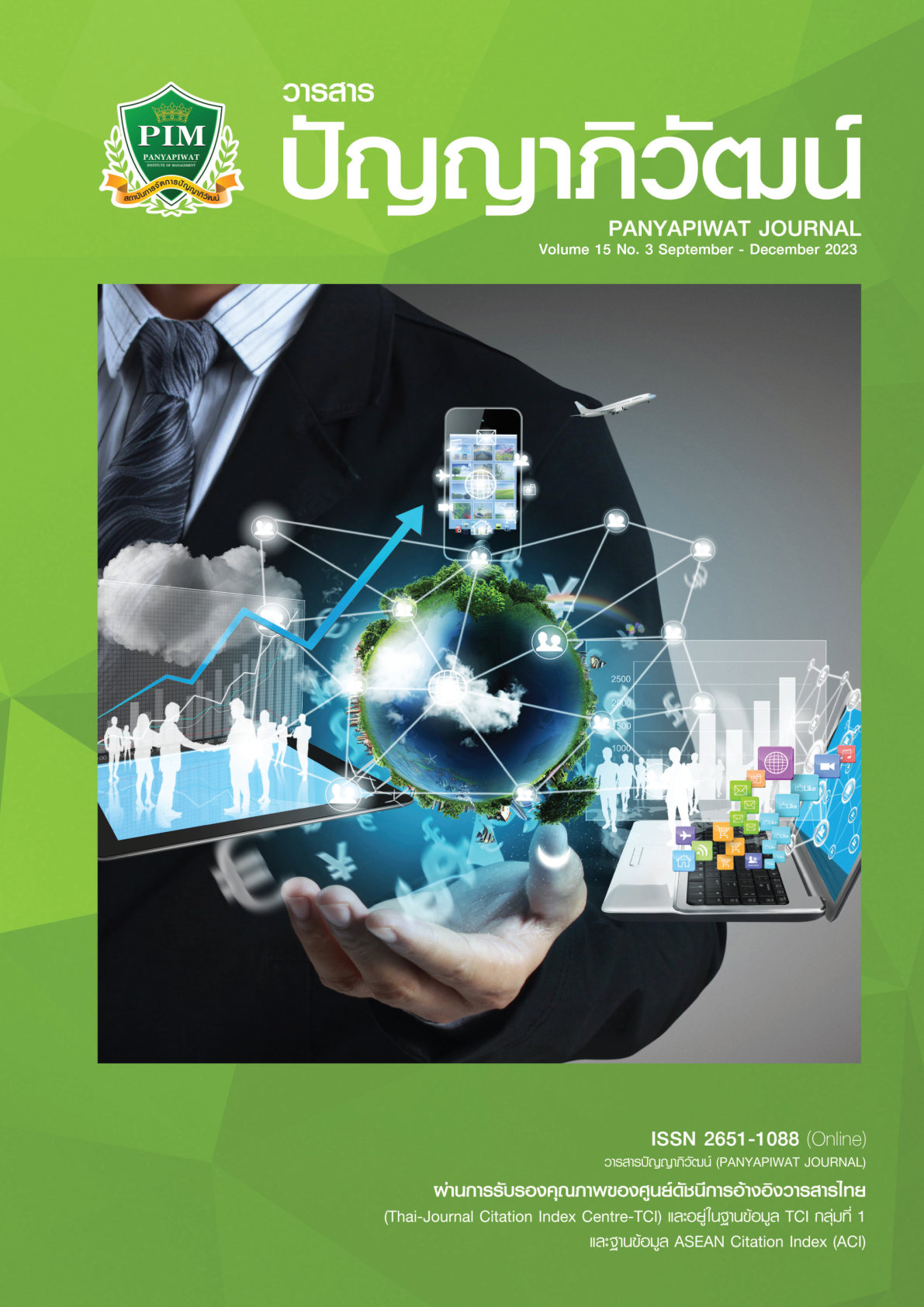การวิเคราะห์ปัจจัยองค์ประกอบเชิงสำรวจของรูปแบบการดำเนินชีวิตนักท่องเที่ยวสูงอายุชาวสิงคโปร์ที่มีรายได้สูงในประเทศไทยภายหลังการแพร่ระบาดของโรคโควิด 19
Main Article Content
บทคัดย่อ
การวิจัยนี้มีวัตถุประสงค์เพื่อศึกษาและวิเคราะห์ปัจจัยองค์ประกอบเชิงสำรวจรูปแบบการดำเนินชีวิต ของนักท่องเที่ยวสูงอายุชาวสิงคโปร์ที่มีรายได้สูงภายหลังการแพร่ระบาดของโรคโควิด 19 การวิจัยนี้เป็นการวิจัยเชิงสำรวจ ประชากรคือ นักท่องเที่ยวชาวสิงคโปร์สูงอายุ 55 ปีขึ้นไป และมีรายได้เดือนละ 2,600 เหรียญสหรัฐขึ้นไปที่เคยมาท่องเที่ยวในไทยห้าปีย้อนหลัง โดยใช้แบบสอบถามออนไลน์ที่มีระดับความเชื่อมั่นเท่ากับ 0.933 ได้กลุ่มตัวอย่างที่ตอบแบบสอบถามครบสมบูรณ์ จำนวน 262 คน ผลการวิจัยพบว่า รูปแบบการดำเนินชีวิตของนักท่องเที่ยวสูงอายุชาวสิงคโปร์คือ การรับประทานอาหาร การพักผ่อนโรงแรมชั้นหนึ่งในเมือง และการเข้าสังคมในกลุ่มเพื่อน โดยคำนึงถึงความปลอดภัยและสุขอนามัยของสถานที่ท่องเที่ยวเป็นหลัก ผลรูปแบบการดำเนินชีวิตของนักท่องเที่ยวประกอบด้วย 8 องค์ประกอบ ซึ่งห้าลำดับแรกคือ สุขอนามัยและความปลอดภัยสูงที่สุด รองลงมาคือ การมีส่วนร่วมกับกิจกรรมทางธรรมชาติและสังคมที่ท้าทาย การเยี่ยมชมแหล่งประวัติศาสตร์อย่างยั่งยืน การเรียนรู้วัฒนธรรมอย่างปลอดภัย และการใช้เวลาพักผ่อนกับเพื่อน ตามลำดับ โดยเพศ อายุ และรายได้ของนักท่องเที่ยวสูงอายุมีความสัมพันธ์ต่อการตัดสินใจในการเลือกรูปแบบการดำเนินชีวิต ข้อค้นพบจากการศึกษานำไปสู่แนวทางการส่งเสริมการตลาดและแหล่งท่องเที่ยวซึ่งส่งผลให้จำนวนนักท่องเที่ยวสูงอายุชาวสิงคโปร์เพิ่มขึ้นและประเทศไทยมีรายได้ที่มากขึ้น
Article Details

อนุญาตภายใต้เงื่อนไข Creative Commons Attribution-NonCommercial-NoDerivatives 4.0 International License.
“ข้าพเจ้าและผู้เขียนร่วม (ถ้ามี) ขอรับรองว่า บทความที่เสนอมานี้ยังไม่เคยได้รับการตีพิมพ์และไม่ได้อยู่ระหว่างกระบวนการพิจารณาลงตีพิมพ์ในวารสารหรือแหล่งเผยแพร่อื่นใด ข้าพเจ้าและผู้เขียนร่วมยอมรับหลักเกณฑ์การพิจารณาต้นฉบับ ทั้งยินยอมให้กองบรรณาธิการมีสิทธิ์พิจารณาและตรวจแก้ต้นฉบับได้ตามที่เห็นสมควร พร้อมนี้ขอมอบลิขสิทธิ์บทความที่ได้รับการตีพิมพ์ให้แก่สถาบันการจัดการปัญญาภิวัฒน์หากมีการฟ้องร้องเรื่องการละเมิดลิขสิทธิ์เกี่ยวกับภาพ กราฟ ข้อความส่วนใดส่วนหนึ่งและ/หรือข้อคิดเห็นที่ปรากฏในบทความข้าพเจ้าและผู้เขียนร่วมยินยอมรับผิดชอบแต่เพียงฝ่ายเดียว”
เอกสารอ้างอิง
Ageing Asia Alliance. (2020). The Asia Pacific silver economy business opportunities report 2020. Ageing Asia. https://ageingasia.com/publications/asia-pacific-silver-economy-business-opportunities-report/
Balderas-Cejudo, M. A. (2019). Towards a deeper understanding of senior tourists: Challenges and opportunities of an emerging market segment. Journal of Tourism and Heritage Research, 2(2), 262-277. http://jthr.es/index.php/journal/article/view/52
Becken, S., & Loehr, J. (2022). Asia-Pacific tourism futures emerging from COVID-19 recovery responses and implications for sustainability. Journal of Tourism Futures, 8(1), 1-14. https://www.emerald.com/insight/content/doi/10.1108/JTF-05-2021-0131/full/pdf
Business Information Centers. (2020). Singapore. Glob Thailand. https://globthailand.com/market/Singapore [in Thai]
Chuan, P. C. (2021). Beyond COVID-19 tourism transformed. Singapore Tourism Board. https://www.stb.gov.sg/content/dam/stb/documents/trade-events-andresources/TXI/Beyond%20COVID-19%20Tourism%20Transformed.pdf
Cohen, E. (1979). A phenomenology of tourist experiences. Sociology, 13(2), 179-201. https://doi.org/10.1177/003803857901300203
Esiyok, B., Kurtulmuşoğlu, F. B., & Özdemir, A. (2018). Heterogeneity in the determinants of length of stay across middle age and senior age groups in thermal tourism. Journal of Travel & Tourism Marketing, 35(4), 531-540. https://doi.org/10.1080/10548408.2017.1374906
Field, A. (2013). Discovering statistics using IBM SPSS statistics: And sex and drugs and rock “N” roll (4th ed.). Sage.
Huber, D., Milne, S., & Hyde, K. F. (2018). Constraints and facilitators for senior tourism. Tourism Management Perspectives, 27, 55-67. https://doi.org/10.1016/j.tmp.2018.04.003
Hwang, J., & Lee, J. (2018). Relationships among senior tourists’ perceptions of tour guides’ professional competencies, rapport, satisfaction with the guide service, tour satisfaction, and word of mouth. Research Article, 58(8), 1331-1346. https://journals.sagepub.com/doi/abs/10.1177/0047287518803199
Kim, M., & Kim, C. (2018). Lifestyle and travel motivation of the elderly in South Korea: Baseline characteristics and the relationship between demographic factors. International Journal of Hospitality & Tourism Administration, 21(3), 1-24. https://doi.org/10.1080/15256480.2018.1464417
Kotler, P., & Armstrong, G. (2012). Principles of marketing. Pearson Education.
Krachangphatwong, N., & Puaratanarunkon, O. (2018). Tourism behavior of the elderly: A case study in Khon Kaen municipality. Business Administration and Accounting Journal Khon Kaen University, 2(3), 34-51. [in Thai]
Krejcie, R. V., & Morgan, D. W. (1970). Determining sample size for research activities. Educational and Psychological Measurement, 30(3), 607-610.
Lianto, F., & Wijaya, S. (2019). Do Asian and non-Asian different? A study of senior tourists’ travel motivation. Journal Ilmiah Manajemen, 9(3), 513-527.
Matichon. (2020, November 9). Hat Yai’s economy has deteriorated heavily: Malaysian, Singaporean and Indonesian customers are infected with the virus. Prachachat Online. https://www.prachachat.net/local-economy/news-551298 [in Thai]
Melon, M., Agrigoroaei, S., Diekmann, A., & Luminet, O. (2018). The holiday-related predictors of wellbeing in seniors. Journal of Policy Research in Tourism, Leisure and Events, 10(3), 221-240. https://www.tandfonline.com/doi/abs/10.1080/19407963.2018.1470184
Ministry of Tourism and Sports. (2020). COVID-19 and its impact on Thai tourism: Thailand tourism situation Q1/2020. Tourism Economic Report, 1(4), 25-29. [in Thai]
Ministry of Tourism and Sports. (2022). National tourism development plan no. 3 (2023-2027). Office of the National Economic and Social Development Council. https://www.nesdc.go.th/ewt_dl_link.php?nid=11684&filename=index [in Thai]
National Innovation Agency. (2022, June 28). National average salary and cost of living. Admission Premium. https://www.admissionpremium.com/entrepreneur/news/4914 [in Thai]
Nicolau, J. L., Losada, N., Alen, E., & Domínguez, T. (2019). The staged nature of decision making among senior tourists. Research Article, 59(4), 602-613. https://journals.sagepub.com/doi/abs/10.1177/0047287519851229
Nithat-ek, S. (2018). Lifestyle and satisfaction of quality tourists from Europe in Riviera area, Prachuap Khiri Khan Province [Master’s thesis]. Thammasat University. [in Thai]
Office of the Permanent Secretary, Ministry of Tourism and Sports. (2022, March 31). Number of foreign tourists entering Thailand classified by age group 2010-2021. http://statbbi.nso.go.th/staticreport/page/sector/th/17.aspx [in Thai]
Patterson, I. (2018). Tourism and leisure behaviour in an ageing world. Oxfordshire.
Plummer, J. T. (1974). The concepts and application of lifestyle segmentation. Journal of Marketing, 38(1), 7-33.
Rahman, M. K., Gazi, M. A. I., Bhuiyan, M. A., & Rahaman, M. A. (2021). Effect of COVID-19 pandemic on tourist travel risk and management perceptions. PLoS ONE, 16(9), 1-18. https://doi.org/10.1371/journal.pone.0256486
Sriampornaekkul, L., & Chantuk, T. (2018). Quality tourism for senior tourists. Journal of Humanities and Social Sciences, Rajaphuk University, 4(1), 12-28. [in Thai]
Suryadi, S., & Subroto, W. T. (2019). Analysis of lifestyle factors that influence individuals following community. IOSR Journal of Research & Method in Education (IOSR-JRME), 9(1), 33-44. https://doi.org/10.9790/7388-0901013344
Tourism Authority of Thailand. (2020). The implementation plan of the project on health safety guidelines. Tourism Authority of Thailand. https://web.thailandsha.com/index#Home [in Thai]
Tsartsara, S. (2018). Definition of a new type of tourism niche-The geriatric tourism. International Journal of Tourism Research, 20, 796-799. https://onlinelibrary.wiley.com/doi/10.1002/jtr.2232
Wanichbancha, K. (2003). The use of SPSS for Window in data analysis (6th ed.). Thammasarn. [in Thai]
Wen, J., Huang, S., & Goh, E. (2020). Effects of perceived constraints and negotiation on learned helplessness: A study of Chinese senior outbound tourists. Tourism Management, 78, 104059. https://www.sciencedirect.com/science/article/pii/S0261517719302572
Zielinska-Szczepkowska, J. (2021). What are the needs of senior tourists? Evidence from remote regions of Europe. Economies, 9(4), 148. https://doi.org/10.3390/economies9040148


